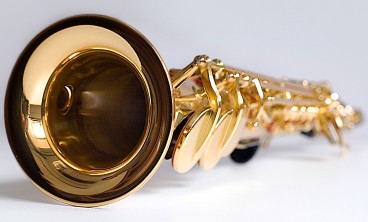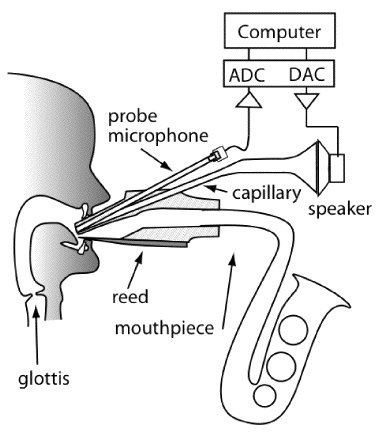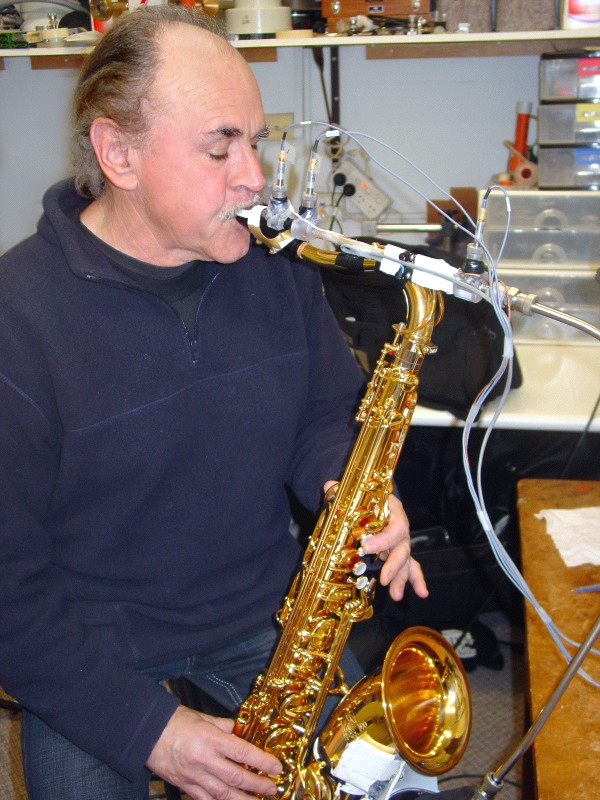Some background about the saxophone
 The saxophone is louder than other woodwinds (clarinet, oboe etc). This loudness comes at a price: it tends to limit the natural playing range. The bore of the saxophone is almost a cone, but the angle of the cone is larger than that of the oboe or bassoon. This means that it radiates sound better from the bell, particularly at high frequencies. However, because those high frequency waves are well radiated, they are not so well reflected at the bell, and the resonances of the instrument are relatively weak at high frequencies. The instrument tends to play at the frequency of the lowest resonance. A register hole (octave key) serves to weaken the lowest resonance and allows players to play the second resonance of the instrument bore. The standard range (less than three octaves, from (written) A#3 to about F#6) uses just the first two resonances. Higher resonances exist, but they are weak and it takes considerable expertise and experience to play them. We give a simple introduction to saxophone acoustics elsewhere.
The saxophone is louder than other woodwinds (clarinet, oboe etc). This loudness comes at a price: it tends to limit the natural playing range. The bore of the saxophone is almost a cone, but the angle of the cone is larger than that of the oboe or bassoon. This means that it radiates sound better from the bell, particularly at high frequencies. However, because those high frequency waves are well radiated, they are not so well reflected at the bell, and the resonances of the instrument are relatively weak at high frequencies. The instrument tends to play at the frequency of the lowest resonance. A register hole (octave key) serves to weaken the lowest resonance and allows players to play the second resonance of the instrument bore. The standard range (less than three octaves, from (written) A#3 to about F#6) uses just the first two resonances. Higher resonances exist, but they are weak and it takes considerable expertise and experience to play them. We give a simple introduction to saxophone acoustics elsewhere.
|
What was the debate about?
Some scientists thought that the influence of the vocal tract in clarinet or saxophone playing was 'negligible', while others thought that the player needed to adjust the vocal tract for every note. Musicians' opinions are also varied, although many agree that the tract configuration could be kept constant for most conditions, and varied only for extreme or exotic effects. No-one really knew: it is difficult for players to be quantitative or even explicit about what they do with their vocal tracts, and it is difficult to make precise measurements inside the vocal tract during playing.
What are the key findings of our recent research?
Some background: The vocal tract has several resonances (which are important in speech and singing). Depending on the shape of the mouth and tongue, vibrations in the air in the vocal tract can be enhanced or inhibited at different frequencies. At the frequency of a resonance, a large sound pressure is produced. We measured the acoustical response of saxophonists' vocal tracts while they played.
• Over the standard range of the saxophone, different players used their vocal tracts in different ways, sometimes making little change at all. In no case was there a consistent relation between resonances of the tract and the note played.
• In the high ("altissimo") range, the professional players in this study all consistently tuned a strong resonance of the vocal tract to a frequency slightly above that of the note to be played.
• None of the amateurs in this study tuned the vocal tract and none of them could play in this altissimo range.
How did we make these measurements?
 We used two special saxophone mouthpieces, fitted with acoustical apparatus, to measure the acoustical response (technically the acoustical impedance spectrum) of saxophonists' vocal tracts while they played. The capillary method, which was used to measure high notes, is shown in the schematic at right (not to scale) and in the photo above. Another method, which used three microphones rather than just one, was used for low notes. It is shown in a photo below.
We used two special saxophone mouthpieces, fitted with acoustical apparatus, to measure the acoustical response (technically the acoustical impedance spectrum) of saxophonists' vocal tracts while they played. The capillary method, which was used to measure high notes, is shown in the schematic at right (not to scale) and in the photo above. Another method, which used three microphones rather than just one, was used for low notes. It is shown in a photo below.
In both cases, a computer synthesises a signal comprising a sum of 224 sine waves. Via an amplifier, loudspeaker and a horn, this becomes a sound source, which is calibrated using known acoustic loads, including a semi-infinite waveguide. (This paper gives review of impedance measurement techniques.) The microphones measure the signal returning from the vocal tract and also the sound produced by the saxophone reed, which vibrates in the player's mouth.
The sound made by the saxophone has components only at a small number of frequencies, the harmonics of the note played, and so it is readily distinguished from our measurement signal in the sound spectrum. For more detail, see the scientific report of this study.
|
How do saxophonists learn to do this? Can anyone learn it?
Our studies don't answer this question. It usually takes saxophone players some years to learn how to modify the vocal tract appropriately: they report that they need to 'hear the note in the head' before playing it, and adjust the tongue appropriately. We cannot say whether anyone can learn it. However, nearly everyone learns, at an early age, how to produce, reliably, the dozens of different vocal tract configurations required to speak one or more languages. Experienced players say that an important part of the technique is learning to 'hear the note in the head' before you play it.
Can the vocal tract affect the timbre, too?
Yes, the vocal tract resonances can affect the timbre, too, as this paper reports. (However, the effect is much weaker for other listeners than it is for the player, because the player can hear the sound in the mouth by bone conduction.)
Implications for other instruments
Why did we do this study?
Our group specialises in the physics of the vocal tract, musical instruments and the ear. So we had appropriate background. Scientifically, it was an outstanding puzzle and we were curious.
This work is part of a broader study of woodwind instruments in which we aim to understand several of the things that one must do to play an instrument well, to understand what an expert does better than a beginner. We expect this information to be useful to music teachers and students: we currently provide a range of introductory multimedia about musical instruments and sound in general. We also collaborate with instrument makers aiming to produce better musical instruments.
Other questions
Does a skilled player use the glottis subconsciously when playing?
Apparently. None of the players to whom we have spoken are aware
of it.
However, the magnitude of the resonances are consistent with a glottis in the nearly closed position, something like the position used for whispering.
Did your method of sound measurement impair the players' ability
to play?
The capillary (one microphone) method is only a minor pertubation. The mouthpiece 'feels' very similar to a normal mouthpiece. Of course the fact that it makes a noise inside the mouth is surprising, but it doesn't hinder normal playing. The three microphone system is more perturbing, because its acoustic impedance is rather lower than that of the capillary. However, it can deliver a stronger signal into the tract, and so gives better results in the presence of noise or other signals. For this study, we used the three microphone method only in the lowest register, and the capillary technique for the middle and high registers.
Is the vocal tract only important for the high range?
No, but that is the only application that we reported in the recent (short) paper. The vocal tract may also be used in adjusting the pitch of notes, and for making difficult note transitions. It is also used to select or to stabilise notes in multiphonics, which are chords played on the saxophone: a relatively recent contemporary technique.
Sounds and pictures

The photo at right shows eminent Sydney jazz player, Col Loughnan, playing the saxophone used in this study. Col, who teaches at the Sydney Conservatorium of Music, waived the anonymity routinely offered to subjects in our study.
In the sound file below, a professional plays G4 and A#5 (written as A5 and C7 for the tenor saxophone). These are the notes used for Figs 1A and 1B in the scientific report of this study.

An amateur plays G4 correctly. He then plays with the fingering for A#5. Because he does not tune the vocal tract resonance to A#5, the instrument plays at its strongest impedance peak, near 200 Hz, which is about G#3.

A professional plays comfortably over the normal range (below about F5) and altissimo range of the tenor saxophone. The two passages cover the range D#3 to A#5 (written F4 to C7) and F3 to G5 (written G4 and A6).

An amateur begins a scale at A#4 (written C6) near the top of the normal range. Above F5 (written G6), he fingers the appropriate keys. However, without appropriate vocal tract tuning, the instrument plays at one of the saxophone's strong impedance peaks that occur at lower frequency.

|
Links for more information
Some papers are reproduced with kind permission of the editors.
- The scientific paper reporting this study is: Chen, J.M., Smith,. J. and Wolfe, J. (2008) "Experienced saxophonists learn to tune their vocal tracts", Science, 319, 726. (There is also a version on Youtube.)
- Chen, J.M., Smith, J. and Wolfe, J. (2011) "Saxophonists tune vocal tract resonances in advanced performance techniques" J. Acoust. Soc. America. 129, 415-426.
- Chen, J-M., Smith, J. and Wolfe, J., (2007) "Vocal tract interactions in saxophone performance", International Symposium on Music Acoustics, Barcelona, Agulló, J. and Barjau, A., eds.
Here are some references to our related work.
- Tarnopolsky, A, Fletcher, N. Hollenberg, L., Lange, B., Smith, J. and Wolfe, J. (2005) "The vocal tract and the sound of a didgeridoo", Nature, 436, 39. (A short report.)
- Tarnopolsky, A, Fletcher, N. Hollenberg, L., Lange, B., Smith, J. and Wolfe, J. (2006)"Vocal tract resonances and the sound of the Australian didjeridu (yidaki) I: Experiment", J. Acoust. Soc. America , 119, 1194-1204.
- Fritz, C. and Wolfe, J. (2005) "How do clarinet players adjust the resonances of their vocal tracts for different playing effects?", J. Acoust. Soc. America 118, 3306-3315.
- Dickens, P., Smith, J. and Wolfe, J. (2007) "High precision measurements of acoustic impedance spectra using resonance-free calibration loads and controlled error distribution", J. Acoust. Soc. America, 121, 1471-1481.
- Dickens, P., France, R., Smith,. J. and Wolfe, J. (2007) "Clarinet acoustics: introducing a compendium of impedance and sound spectra". Acoustics Australia, 35, 17-24.
Other scientific papers are at this link.
|

